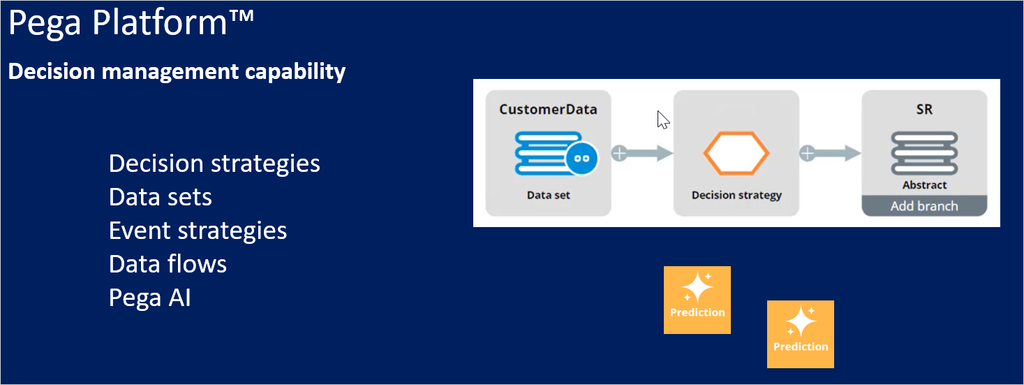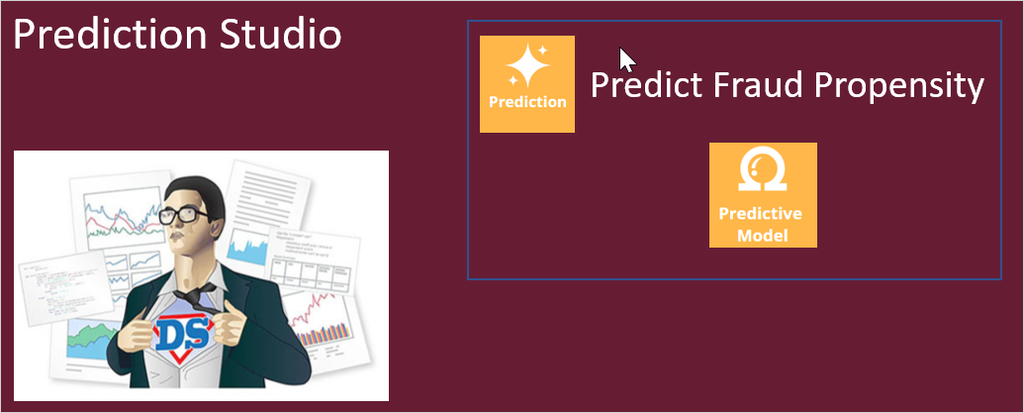
Predictive models drive predictions
Introduction
With the decision management capability of Pega Platform™, you can enhance applications to help optimize business processes, predict customer behavior, analyze natural language, and make informed decisions to better meet customers' needs and to achieve positive business outcomes.
Video
Transcript
This video introduces you to Pega AI, a feature of the decision management capability of Pega Platform™.
Other decisioning features of the Pega Platform include:
- Decision strategies to improve customer experience and deploy intelligent processes based on behavioral and operational data.
- Data sets to read and write the data used in the decision strategies.
- You can use event strategies to detect patterns in data streams and react to them.
- And to ingest, process, and move data from one or more sources to one or more destinations, you can configure data flows as scalable and resilient data pipelines.
Decision management uses Pega AI to make predictions about customer behavior, successful case completion, the topic of an incoming message, or other subjects to make the decisions more relevant.
Decision management is a Pega Platform capability. You can apply decision management to any application that is built on Pega Platform.
Predictions differ to suit the domain they are used in, but one or more predictive models drive them all.
A data scientist can create a predictive model in Pega Platform or an external environment that can export the model as a PMML or H2O file. Another option is to connect to a machine learning service such as Google ML or AWS SageMaker.
If an insurance company wants to use Pega Process AI™ to route incoming claims that might be fraudulent to an expert based on the outcome of a predictive model, the data scientist creates a fraud model to drive a new case management prediction in Prediction Studio.
Prediction Studio is the dedicated workspace where you manage the life cycle of predictive models and the predictions they drive.
A prediction is a hand-off to an application developer, who can then use the prediction in a decision step in the case type to route cases more accurately. This strengthens the separation of concerns.
You can use Pega Customer Decision Hub™ to make next-best-action decisions for your customers.
Customer Decision Hub predictions can predict customer behavior, such as which customer is about to churn or predict the likelihood that a customer clicks on a web banner to support the decision on which banner to show to a customer.
Pega Adaptive Decision Manager (ADM), a key component of the decision management capability allows a data scientist to configure self-learning, adaptive models that continuously improve predictions about business processes and customer behavior.
An adaptive model rule typically represents many adaptive model instances because each unique combination of the model context generates a model.
In Customer Decision Hub, adaptive models drive many predictions that come with the product out of the box, such as the Predict Web Propensity prediction that predicts the likelihood that a customer clicks a web banner.
Customer Decision Hub predictions have several features specific for the domain, such as a control group for which the prediction outputs a random propensity instead of the propensity that is generated by the adaptive model instance.
Comparison of the control group and the model propensity-based group allows you to measure the lift in a success rate that the AI generates, an important business metric.
Also, Customer Decision Hub predictions feature a response timeout setting. After the timeout expires, a negative response is recorded.
The response timeout setting depends on the use case. For example, in a web use case, several minutes suffice, while in an outbound email campaign, the response timeout is set to several days to allow customers enough time to respond.
You can further enhance the prediction by using the output of a predictive model as a predictor in the adaptive model.
The Pega Customer Service™ application uses the natural language processing capability of decision management to analyze incoming text and route the messages based on the topics and entities detected.
Pega Customer Service uses Text analytics predictions that are distinctly different from both case management predictions and Customer Decision Hub predictions.
Text analytics predictions use predictive models to detect the topic of an incoming message that the application can use to optimize the routing of the message to the relevant department.
Secondly, text analytics predictions use entity extraction models that qualify text as, for example, an account number, a postal ZIP code, or an address.
The application can use this information to fill relevant fields in a case automatically.
Finally, the text analytics predictions come with a sentiment model that can route or prioritize negative messages to improve the customer experience.
Feedback on the detected topics, entities, and sentiment by CSRs improves the performance of the text analytics prediction over time.
This video has concluded. What did it show you?
Pega AI allows you to improve business processes and customer engagement by using predictions.
- Predictive models drive the predictions.
- The predictive models can be static or adaptive.
- Predictions are managed in Prediction Studio.
This Topic is available in the following Modules:
If you are having problems with your training, please review the Pega Academy Support FAQs.
Want to help us improve this content?




